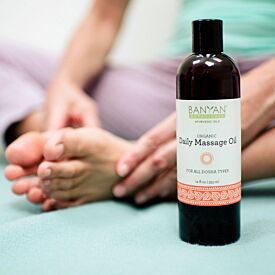Low Back Discomfort
Low back discomfort is extremely common, causing significant challenges in up to 84% of people worldwide at some point in their life.1 Furthermore, this problem costs Americans over $100 billion annually.2 Despite the amount of money spent, there are still many who continue to struggle with lower back discomfort.
Slowly, the medical community is beginning to appreciate alternate modalities of bringing comfort to this structurally very important part of the body. After years of treatment with painkillers, steroid treatments, and even surgery, research is finally agreeing that practices such as massage, yoga, and spinal manipulation can be very helpful.3
This month, we will take a closer look at the low back, energetically and structurally, from an Ayurvedic perspective.
The Low Back
The low back, along with the pelvis and thighs, are sites in the body that vata likes to consider home.4 The space within the pelvis, the large bony structures of the pelvic girdle and femurs, as well as the extensive nerve plexuses that exit from the lower spinal cord, all require vata for their form and function. But, as we know, like increases like. And without proper balance and care, vata can easily become elevated, displaced, or blocked in these same locations.
Also consider the low back as a strong supportive structure. It holds and supports the entire torso and head. As such, a strong back gives an energetic sense of support to our entire being.
Causes of Low Back Discomfort
Consider low back discomfort in two ways:
-
Vata imbalance. The cold quality of vata brings about constriction and tightness, leading to pain. As channels constrict (whether it be blood vessels, nerve impulses, or channels for prana flow), the cold can completely block the channel. The cold quality also stimulates muscles to spasm and tighten. Dryness slowly erodes tissue and causes them to lose their flexibility and full form.
Low back discomfort can certainly involve other doshas as well, but vata is generally always at the core since the other doshas disrupt proper movement through channels. - Poor support. Let’s revisit the energetic sense of support that the back gives. Often times there is not an apparent imbalance or dysfunctional flow of vata, but with close observation, you may cue into a posture where the back gives in and the abdomen protrudes out, along with a sense that the client is trying to take on the burdens of the world alone. A strong core also provides significant support to the torso. Without this support, the back is overtaxed. The second and third chakras (seated in the abdomen) are the seat of emotional stability and personal power, respectively. The health of these two chakras will translate to the low back, as well.
If you read about the risk factors for low back discomfort, you will find things like obesity, physically strenuous work, psychologically strenuous work, job dissatisfaction, anxiety, and depression.5 All of these can be traced back to one of the two roots discussed above.
Doshic Differences in Discomfort
Again, remember that vata is always involved. But let us examine how different doshas involved can affect the nature of the discomfort in the low back.
- VATA. Generally sharp or throbbing. Can be variable. Warmth will improve the pain, where as cold aggravates the pain. Travel, late nights, high movement, are triggers.
- PITTA. Burning, sharp pain. Can worsen midday and with overuse (usually involves some form of irritation of the muscles or nerves). Pitta reducing and cooling activities and treatments help the pain.
- KAPHA. Stable, dull pain. Caused by lack of movement, obesity, constipation, congestion, or a sedentary lifestyle. Warmth will improve the pain.
It is important to always consider serious causes of low back discomfort, especially when the pain is persistent and not showing relief or is worsening. Making a referral to another practitioner is crucial to rule out more serious causes, such as malignancy or an abscess.
In the next article we will discuss Ayurvedic methods to pacify discomfort in the low back, with a revisit to the special Ayurvedic treatment of basti (discussed in more detail in the Vine article, Basti: The Primary Treatment of Vata.
References
1 Woolf A, Pleger B. “Burden of Major Musculoskeletal Conditions.” Bull World Health Organ. 81, no 9 (2003):646
2 Katz J. “Lumbar Disc Disorders and Low-Back Pain: Socioeconomic Factors and Consequences.” J Bone Joint Surg Am. 88 Suppl2 (2006):21.
3 “Low Back Pain,” National Institute of Health: National Center for Complementary and Integrative Health, retrieved on August 10, 2015, https://nccih.nih.gov/health/pain/lowback.htm.
4 Lad, Vasant. Textbook of Ayurveda Volume 1: Fundamental Principles of Ayurveda. Albuquerque: The Ayurvedic Press, 2002.
5 Stephanie Wheeler et al. “Evaluation of Low Back Pain in Adults.” UpToDate. August 4, 2015. http://www.uptodate.com/contents/evaluation-of-low-back-pain-in-adults?source=search_result&search=low+back+pain&selectedTitle=1%7E147












